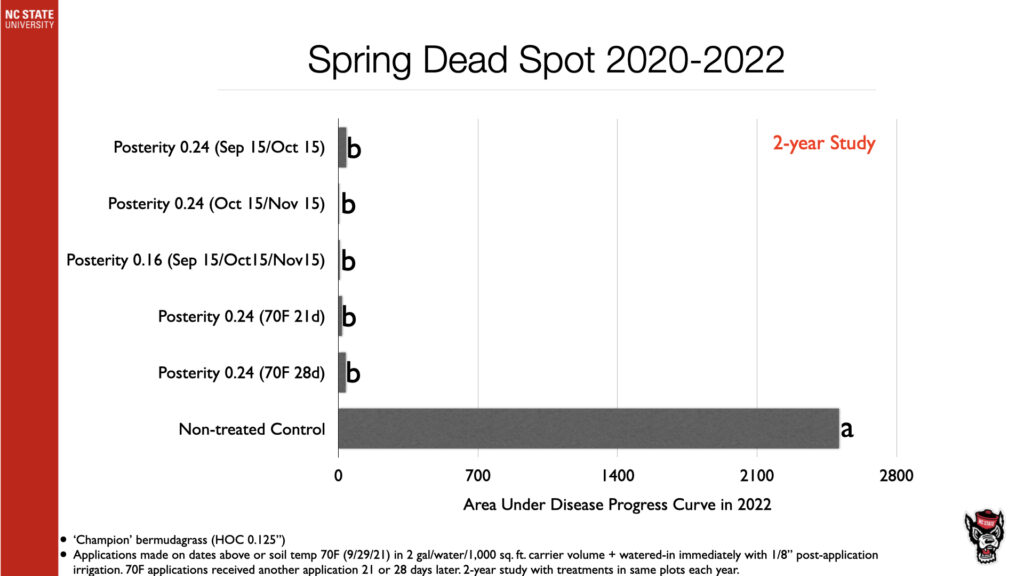Review of Spring Dead Spot and Large Patch Trials From 2021-22
go.ncsu.edu/readext?867805
en Español / em Português
El inglés es el idioma de control de esta página. En la medida en que haya algún conflicto entre la traducción al inglés y la traducción, el inglés prevalece.
Al hacer clic en el enlace de traducción se activa un servicio de traducción gratuito para convertir la página al español. Al igual que con cualquier traducción por Internet, la conversión no es sensible al contexto y puede que no traduzca el texto en su significado original. NC State Extension no garantiza la exactitud del texto traducido. Por favor, tenga en cuenta que algunas aplicaciones y/o servicios pueden no funcionar como se espera cuando se traducen.
Português
Inglês é o idioma de controle desta página. Na medida que haja algum conflito entre o texto original em Inglês e a tradução, o Inglês prevalece.
Ao clicar no link de tradução, um serviço gratuito de tradução será ativado para converter a página para o Português. Como em qualquer tradução pela internet, a conversão não é sensivel ao contexto e pode não ocorrer a tradução para o significado orginal. O serviço de Extensão da Carolina do Norte (NC State Extension) não garante a exatidão do texto traduzido. Por favor, observe que algumas funções ou serviços podem não funcionar como esperado após a tradução.
English
English is the controlling language of this page. To the extent there is any conflict between the English text and the translation, English controls.
Clicking on the translation link activates a free translation service to convert the page to Spanish. As with any Internet translation, the conversion is not context-sensitive and may not translate the text to its original meaning. NC State Extension does not guarantee the accuracy of the translated text. Please note that some applications and/or services may not function as expected when translated.
Collapse ▲Each year our program conducts 60 to 75 fungicide trials on various turfgrass diseases. Fall disease management trials focus on diseases of warm-season grasses and those diseases include spring dead spot and large patch. As promised from social media, this post will detail the results from our spring dead spot and large patch trials from fall 2021 into spring of 2022. However, before focusing in on the details of these 8 trials, we should spend a minute discussing application strategies for these two diseases.
For spring dead spot, we suggest making preventative applications when soil temperatures decline to 70oF, which typically has been late September to early October in Raleigh, NC. Follow up applications should be made 21 to 28 days after the initial application. Based on some of our trials, it seems like 21 days is the more appropriate re-application timing. All of our spring dead spot treatments are irrigated in immediately with 1/8 inch of water to ensure that the fungicides are getting to where the pathogens reside.
Preventative large patch applications for St. Augustinegrass and centipedegrass should be initiated when soil temperatures decline to 80oF which is typically in late August or early September in Raleigh, NC. For zoysiagrass, the preventative applications should start when soil temperatures decline to 70oF. In order for these fungicides to be successful, they need to be applied in at least 88 gallons/acre (2 gallons/M). The large patch pathogen attacks the leaf sheath, therefore more water in the spray tank is necessary to ensure the fungicide is getting on target. Our research continues to indicate that fall applications are most critical for suppression of large patch in the Carolinas. Spring applications may be necessary in cool-wet springs and can compliment a strong fall based application program.
2021-22 Spring Dead Spot & Large Patch Trials
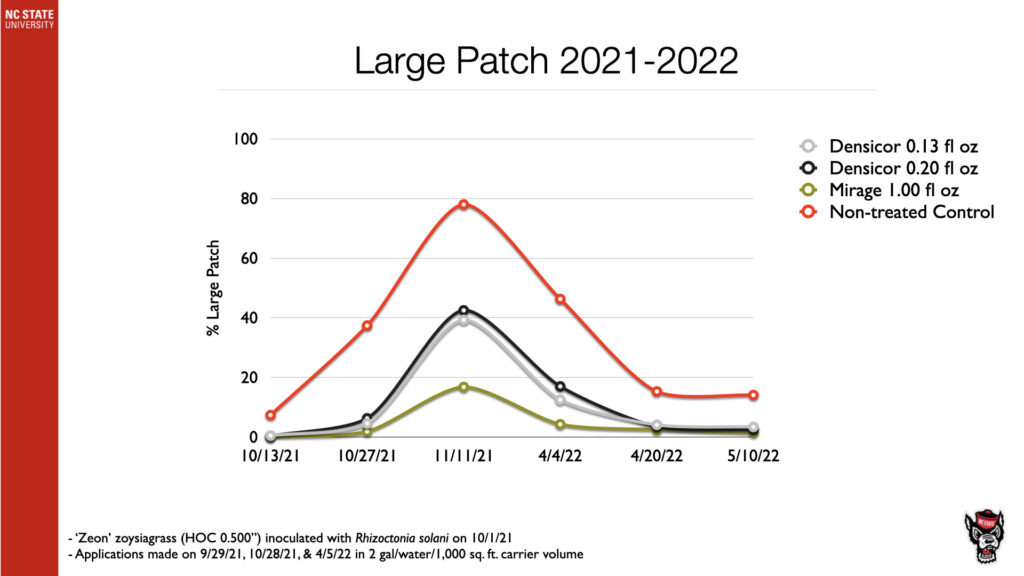
In zoysiagrass, Densicor under extreme large patch pressure reduced large patch severity. Mirage performed better in this trial. Do note that this trial area was severely affected with large patch, so this trial like many of the trials we conduct, was a worse case scenario. Both fungicides are labeled for golf course turf only.
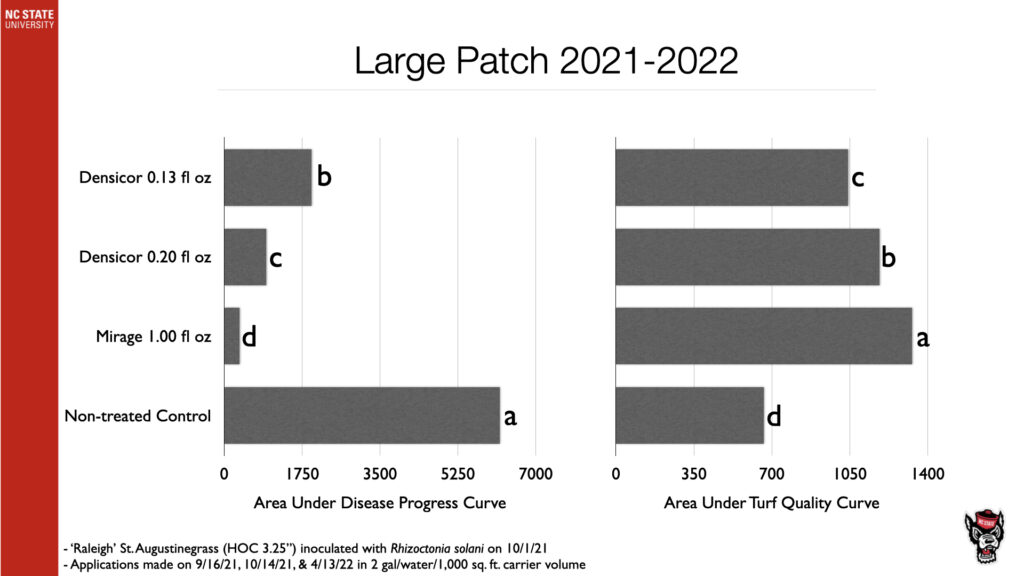
In St. Augustinegrass, Densicor under extreme large patch pressure reduced large patch severity. The 0.20 rate of Densicor was significantly better than the 0.13 rate. Mirage performed better in this trial. Do note that this trial area was severely affected with large patch, so this trial like many of the trials we conduct, was a worse case scenario. Both fungicides are labeled for golf course turf only.
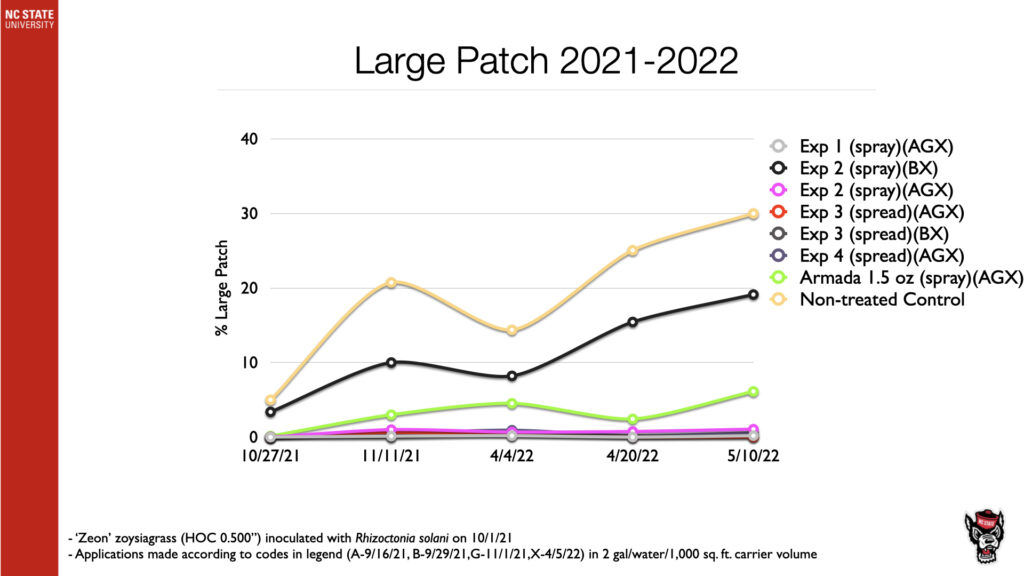
In zoysiagrass, we tested experimental granular formulations of fungicides that suppress large patch as well as the sprayable formulations. Hopefully, these products will be on the market in the near future and available to all turf application sites.
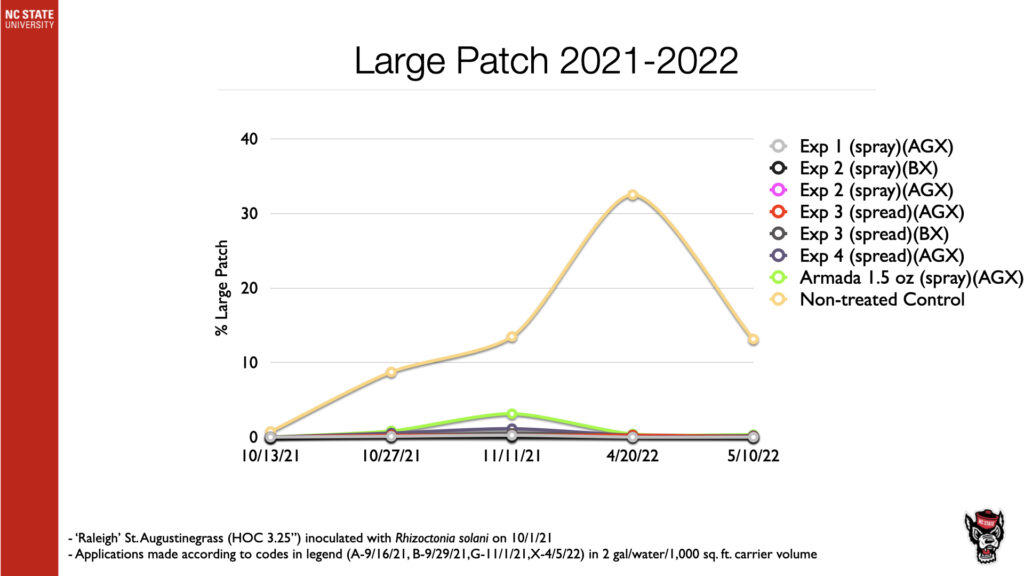
In St. Augustinegrass, we tested experimental granular formulations of fungicides that suppress large patch as well as the sprayable formulations. Hopefully, these products will be on the market in the near future and available to all turf application sites.
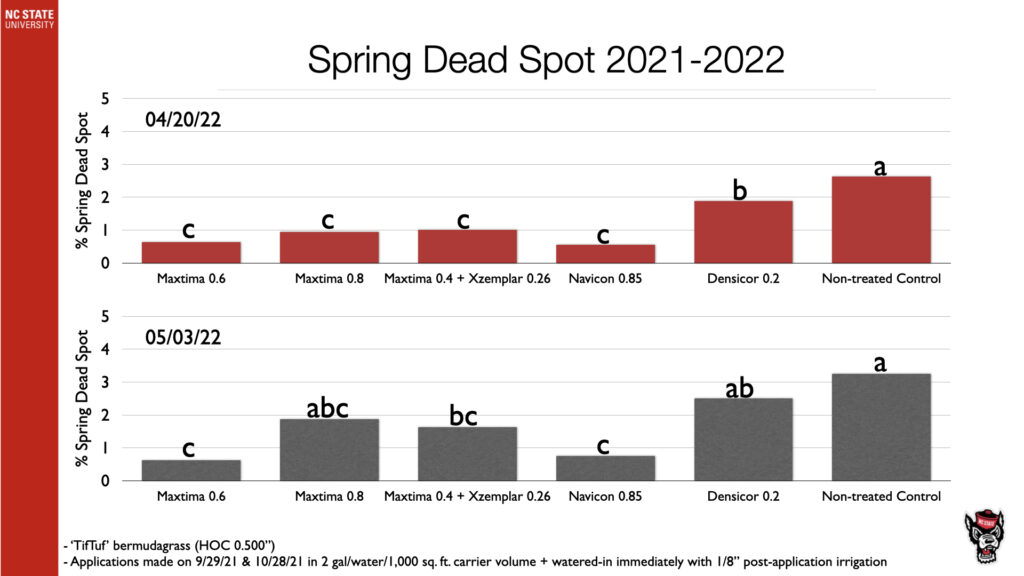
In fairway height bermudagrass on native soil, all treatments suppressed spring dead spot compared to the non-treated control on 4/20/22. However, on our rating on 5/3/22, statistical separations weren’t as clear, but the trends were very similar to the 4/20/22 rating date. This was likely due to the cool-dry April slowing the green-up of bermudagrass at the trial location. Conditions such as these present challenges when rating this disease. Take home message … treatments containing Maxtima or Navicon performed well.
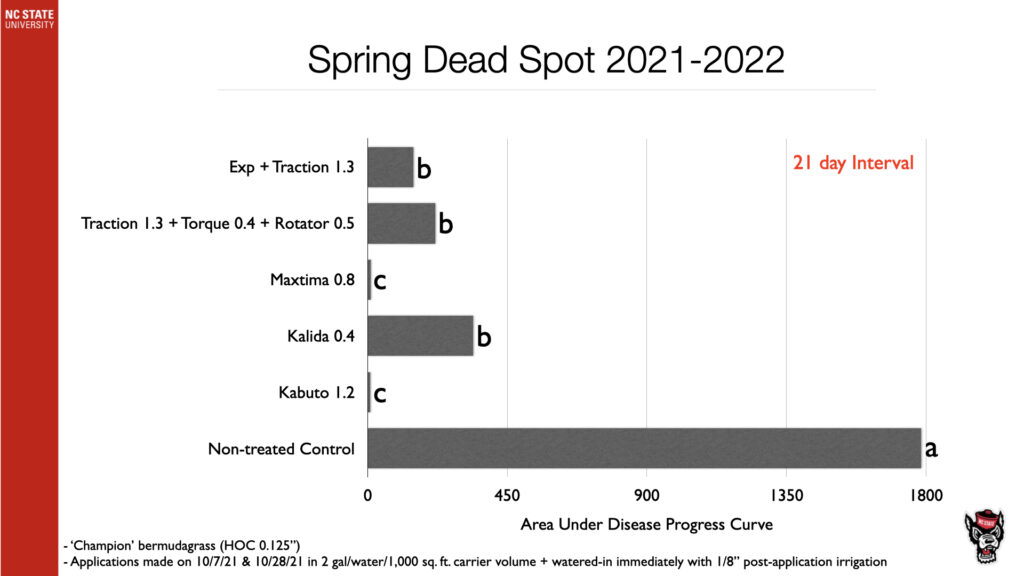
On a sand based ultradwarf bermudagrass putting green, all treatments suppressed SDS when compared to the non-treated control throughout this study. Maxtima (0.8) and Kabuto (1.2) provided the best suppression of SDS in this trial.
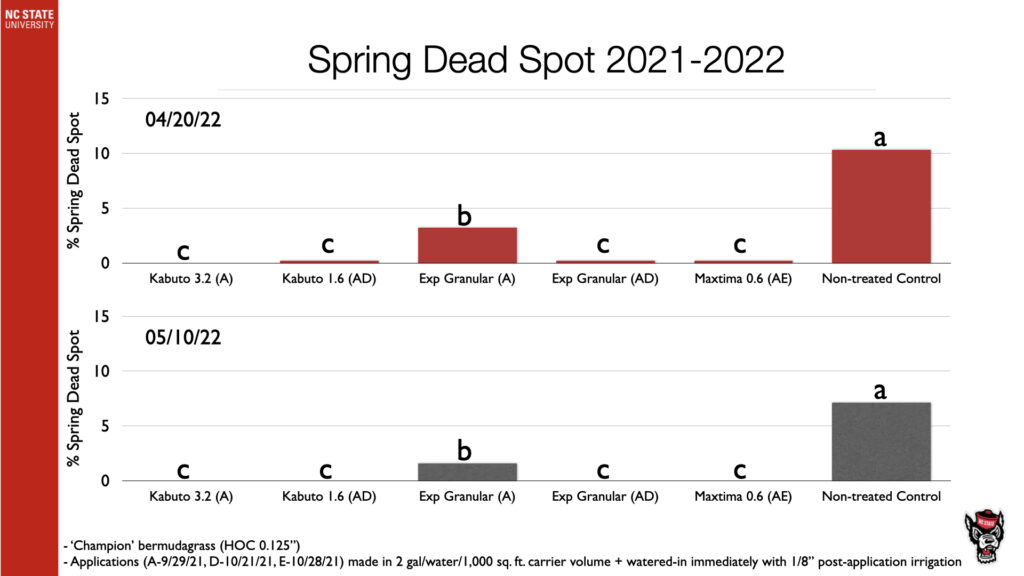
On a sand based ultradwarf bermudagrass putting green, all treatments suppressed SDS when compared to the non-treated control on both rating dates. Kabuto and Maxtima have perennially been excellent performers for suppression of SDS. This trial is interesting because it documents that a single rate of Kabuto (3.2) provides excellent suppression of SDS. Moreover, an experimental granular formulation of a fungicide provided excellent control of SDS as well.



